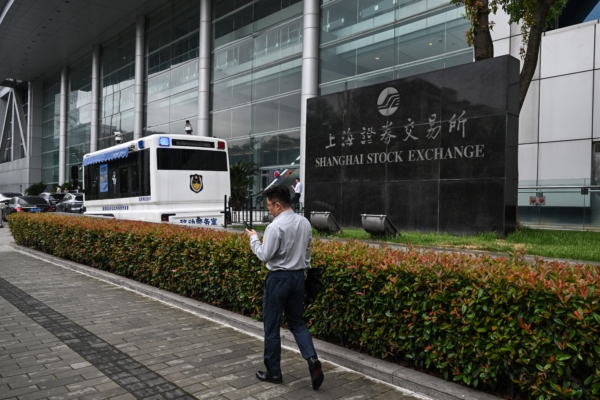The Chinese stock market has experienced six consecutive weeks of decline, with the Shanghai Composite Index falling below the 3000-point mark again. Following a rebound, the last trading day of the first half of the year on June 28th (Friday) ended without reclaiming the 3000-point threshold. Analysts believe that the CCP’s use of stabilization measures to rescue the market is unsustainable, and with the Chinese economy faltering, a turnaround in the stock market seems unlikely.
On the afternoon of the 28th, the three major indices in Beijing, Shanghai, and Shenzhen initially opened lower but later experienced volatile rebounds. By the afternoon close, the Shanghai Composite Index (SHCOMP) ended at 2967 points, up 0.73%. This marked the second rebound after dropping below 3000 points, but it did not surpass the magnitude of the first rebound on the 26th.
During the first half of this year, while global stock markets on average reached new highs, Chinese stock markets performed poorly with all three major indices falling. Out of over 5300 listed stocks, fewer than 800 saw price increases.
The Shanghai Composite Index has repeatedly fallen below the 3000-point mark since February. The latest downturn began on May 20th, with the SHCOMP hitting a low of 2933.33 on June 21st.
On the 26th, the indices experienced a rebound amid volatility, with over 4500 stocks rising in both Shanghai and Shenzhen. Large-scale buybacks of stocks by state-owned and state-controlled enterprises contributed to this rebound.
Investors expressed relief as the market briefly turned bullish after more than a month of declines, but as anticipated by some, the market fell across the board the next day.
On June 27th, the A-share market opened and closed lower throughout the day, contrasting sharply with the previous day as more than 4700 stocks saw declines. Trading volumes in Shanghai and Shenzhen continued to shrink for three consecutive days.
Calls for intensified government efforts to rescue the market have resurfaced, reflecting a recurring theme in China’s stock market in recent years.
Since the sharp decline in China’s stock market in February, the CCP has continuously introduced new regulations to vigorously “rescue” the market. However, subsequent stock market gains have been precarious; in May, the SHCOMP briefly surged to 3174 points, prompting speculation about a potential recovery. Yet this momentum proved short-lived, quickly dropping back below 3000 points.
This cycle has intensified pessimism in the Chinese market, with investors lamenting and even venting anger. Despite occasional rebounds, investor sentiment remains generally tepid. Many have posted messages like “Mian A” in stock forums, indicating disillusionment and warnings against scams.
Senior financial commentator LT, in his media program, remarked that the CCP’s efforts to prevent major A-share declines through stabilization measures and artificially creating bull markets are unsustainable and viewed skeptically by global investors.
LT explained that since the change in leadership at the China Securities Regulatory Commission (CSRC), measures such as banning short-selling, restricting major shareholders from reducing holdings, and halting new stock issuances have been non-market behaviors aimed at preventing market declines. These measures cannot be sustained, as evidenced by the recent decision to resume initial public offerings leading to another downturn. This reflects the fragile market foundation of China’s current stock market.
Analysis: Challenges to a Real Recovery in China’s Stock Market
Why has China’s stock market become such a quagmire?
Qin Peng, a commentator based in the United States, stated to Da Ji Yuan on June 29th that there are several reasons why China’s stock market has once again fallen below 3000 points. Fundamentally, the stock market reflects the overall domestic and international political and economic environment. With China’s economy currently in decline, a positive stock market outlook is unlikely. The CCP’s market rescue measures have not fundamentally addressed economic issues and have had limited effectiveness.
Qin Peng analyzed that the CCP’s current measures mainly focus on supporting the real estate sector, promoting expanded exports, and superficially stimulating consumption. However, there has been no significant stimulus to consumption by distributing funds to the public. In terms of investment, China’s private enterprises, a major investment force, have significantly reduced their investment activities. With the overall economy struggling, rescuing the stock market becomes a futile effort.
Qin Peng also pointed out that another reason why China’s stock market cannot recover is because it was initially designed by CCP elites as a means of raising funds through IPOs and other stock market activities, often with falsified packaging and inflated valuations. The lack of genuine legal oversight has resulted in occasional penalties that do little to deter misconduct, leading to a deteriorating market and widespread disillusionment among investors who repeatedly fall victim to fraud and deception. Many have become so disheartened that they have withdrawn from A-share investments.
Industry experts generally agree that the stock market’s fortunes are closely tied to economic conditions. For sustainable recovery in China’s stock market, economic revitalization and restoration of corporate profitability are essential. However, achieving these goals appears increasingly challenging.
Continued Economic Downturn in China
Recent official data released by the CCP indicates a dire overall economic situation facing China.
The once-thriving real estate sector in China is now suffering greatly, despite numerous government measures aimed at stimulating housing sales. In May of this year, prices of new commercial residential buildings in 70 major and medium-sized cities nationwide fell by 0.71% compared to the previous month, marking the largest monthly decline since October 2014. Similarly, prices of second-hand homes experienced their sharpest decline since the current data collection method was introduced in 2011.
China’s typically robust catering industry is also showing signs of decline.
Data from the CCP’s National Bureau of Statistics released in April showed that from January to March 2024, approximately 460,000 catering enterprises closed their doors, an increase of about 230% from the same period last year. March alone saw 180,000 restaurants shut down.
Recently, the CCP’s Ministry of Finance reported on fiscal revenue and expenditure, stating that from January to May, total tax revenue nationwide decreased by 5.

